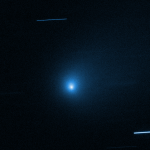
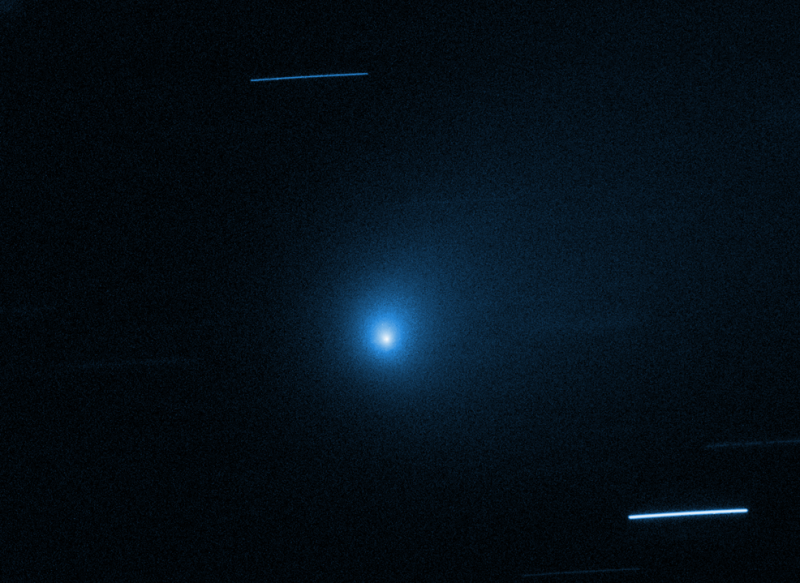
Comet 21/Borisov as seen by the Hubble Space Telescope. The streaks are background stars. Image via NASA/ ESA/ K. Meech (University of Hawaii)/ D. Jewitt (UCLA)/ Hubblesite.
Last year, comet 21/Borisov became the second known interstellar object – and first confirmed interstellar comet – to pass through our solar system after originating somewhere else in our galaxy. Initially, it seemed to resemble comets in our own solar system. Now, scientists who’ve been analyzing its composition using the Hubble Space Telescope (HST) have found that 21/Borisov also has some striking differences. Borisov has been found to contain much more carbon monoxide than our solar system’s comets, suggesting it originated from a star significantly cooler than our sun … a red dwarf.
Researchers published the latest peer-reviewed findings in the journal Nature Astronomy on April 20, 2020.
The Cosmic Origins Spectrograph (COS) on Hubble observed the comet on four separate occasions, from December 11, 2019, to January 13, 2020. By doing so, the researchers could study how the composition of the comet changed as it approached closest to the sun. Borisov contained carbon monoxide, oxygen and water, nothing too surprising. But then they noticed something unusual; the comet’s coma, the large gas cloud surrounding the nucleus that makes comets look fuzzy, contained much more carbon monoxide than expected. In fact, there was 50% more carbon monoxide than water vapor. That’s three times as much as found in any other comet observed in our inner solar system. The water measurement for comparison was made by NASA’s Neil Gehrels Swift Observatory.
Dennis Bodewits of Auburn University in Alabama, who led the research team, said in a statement:
The amount of carbon monoxide did not drop as expected as the comet receded from the sun. This means that we are seeing the primitive layers of the comet, which really reflect what this object is made of. Because of the abundance of carbon monoxide ice that survived so close to the sun, we think that comet Borisov comes from a much colder place and from a very different debris disk around a star than our own.
Jian-Yang Li, a senior scientist at the Planetary Science Institute (PSI), said:
The biggest news is probably the first measurement of the CO composition in a sample from another star. This has never been possible to do due to the enormous distance to another planetary system and the extreme faintness of these small objects around other stars. Given the frequency of recent discoveries of such interstellar objects – two in just two years – and thanks to the advance of telescopes and survey techniques, we can expect more and more such objects discovered and characterized in the near future. This comet may represent the start of a new era in studying extrasolar planet formation.
Kathleen Mandt, a planetary scientist from the Johns Hopkins University Applied Physics Laboratory (JHUAPL) and another study author, added:
We’ve been studying the composition of comets here for decades and using this information to understand how planets in our solar system formed and evolved. Measuring the composition of a comet from another planetary system was an opportunity we couldn’t miss! Even though the composition of comets in our solar system can vary significantly from one comet to the next, we have never seen a comet this close to the sun with this much carbon monoxide compared to water.
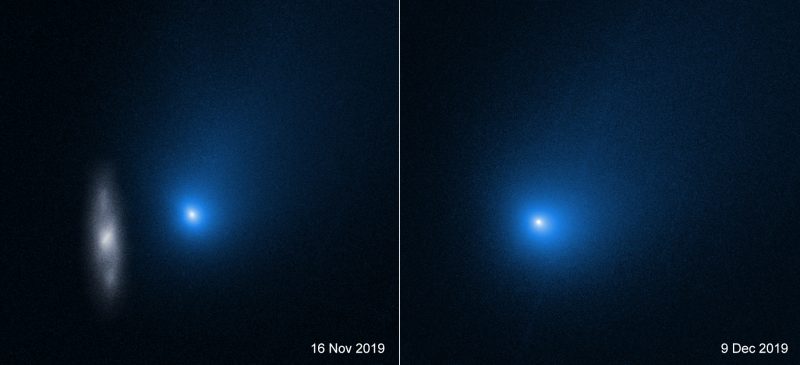
Two separate images of comet 21/Borisov from the Hubble Space Telescope. Image via NASA/ ESA/ D. Jewitt (UCLA)/ JHUAPL.
So what does all this mean?
Carbon monoxide ice is more volatile than water ice, so it doesn’t take much heat to release it from the nucleus of a comet. In our solar system, this ice can start sublimating into space at 11 billion miles – twice the distance of Pluto – from the sun. Water ice, however, will only start doing this when a comet is about 200 million miles from the sun. That’s about the distance of the inner edge of the main asteroid belt between Mars and Jupiter.
Therefore, the rate of water ice outgassing from a comet is normally much higher than carbon monoxide by the time the comet reaches the inner solar system. But with Borisov, it was the opposite. According to Bodewits:
What Hubble measured in comet Borisov is not a property of most solar system comets. That’s why comet Borisov stood out for us because we reasoned that Borisov is likely a representative of the star system it comes from.
To explain this, the scientists suggest that Borisov originated from a carbon-rich disk of icy debris orbiting a red dwarf star. The comet would have started its journey much colder than comets in our solar system, since red dwarf stars, the most common in the galaxy, are much cooler than our sun. According to graduate student John Noonan of the Lunar and Planetary Laboratory (LPL) at the University of Arizona, Tucson:
These stars have exactly the low temperatures and luminosities where a comet could form with the type of composition found in comet Borisov.
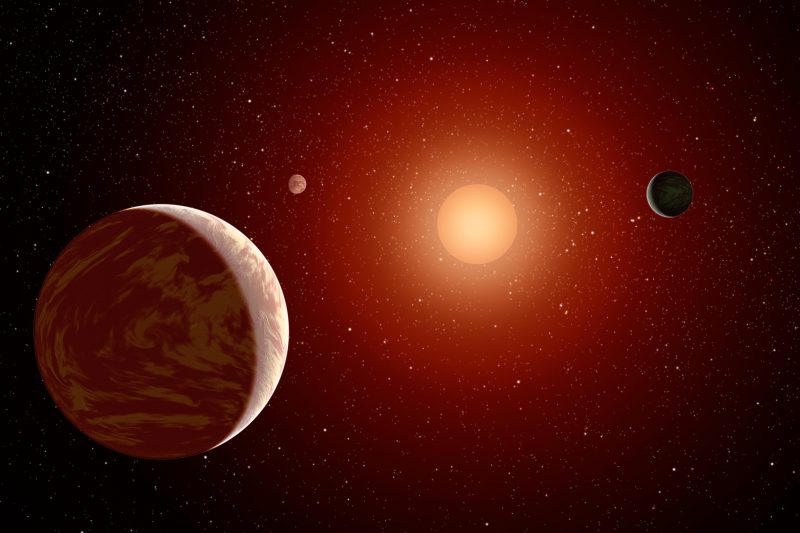
Artist’s conception of a red dwarf star with three planets. New analysis of the composition of interstellar comet 21/Borisov suggests it originated from a planetary formation disk around a red dwarf. Image via NASA/ JPL-Caltech/ JHUAPL.
Bodewits said:
Borisov’s large wealth of carbon monoxide implies that it came from a planet formation region that has very different chemical properties than the disk from which our solar system formed. The origins and formation of our own comets are not well understood. We hope that the difference between solar system comets and future objects like this will help us study comet formation and evolution better.
Li also said:
The high amount of CO is an indication that it comes from a very cold place, either extremely far away from its host star or from a relatively cold star. We think it’s more likely to be the latter case – it comes from a cold red dwarf because there are far more red dwarfs in our Milky Way galaxy than other hotter stars. However, we are still far from saying exactly what’s going on around its host star when planets formed there.
So if Borisov came from a red dwarf star, how did it escape?
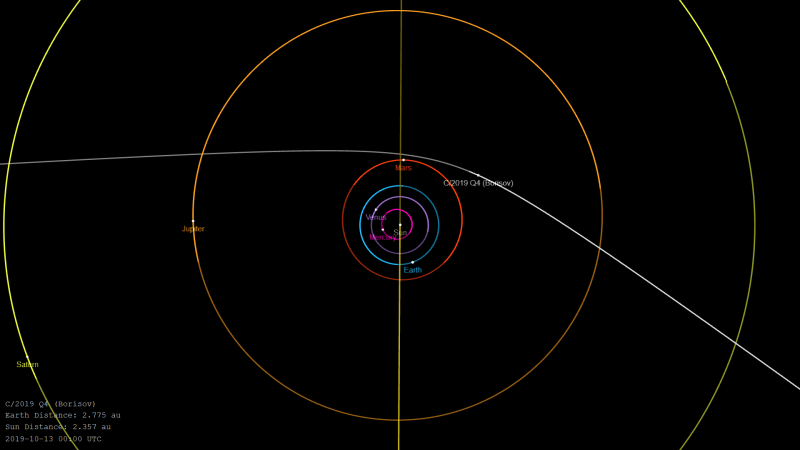
2I/Borisov’s orbit. The “2I” stands for “2nd interstellar.” In other words, this is only the 2nd object from a distant solar system known to have swept past our sun. Its perihelion – or closest point to the sun – is just outside the orbit of Mars. Image via Wikimedia Commons user Drbogdan/ NASA.
It may have been gravitationally kicked out by a large gas giant planet, similar to how Jupiter has altered the trajectories of comets and asteroids in our solar system with its powerful gravity. Bodewits said:
If a Jupiter-sized planet migrates inward, it could kick out a lot of these comets.
Borisov was first seen on Aug. 30, 2019, by amateur astronomer and comet hunter Gennadiy Borisov in Crimea. Hubble and other telescopes have observed it since then, and it will eventually leave the solar system, going back to deep space.
Being able to study a comet from another solar system will help scientists learn more about the conditions and processes where exoplanets form. According to Li:
So far we’ve discovered thousands of extrasolar planets around other stars, but we know nothing about the formation conditions and processes. This comet is the first sample from another star that we can directly measure the composition to infer what’s going on when planets form around another star. However, it is still too far from knowing exactly what happened during the planetary formation process around other stars from this one single sample.

Dennis Bodewits at Auburn University, who led the new study about comet 21/Borisov. Image via Auburn University.
Although Borisov is the first interstellar comet ever detected, it is actually the second interstellar object known to have entered our solar system. The first one was ‘Oumuamua, which traveled through the inner solar system in 2017 before leaving the solar system again. That object, however, did not have the characteristics of typical comets, and the intense debate still continues as to just what it was. The most recent theories suggest it was either a rocky shard from a planet or other large object that was destroyed or perhaps a “cosmic dust bunny.”
The Hubble observations of Borisov were a unique and exciting opportunity to study something never seen before, a comet from another solar system. If there’s one, then there are probably more waiting to be discovered as their voyage temporarily brings them close to home.
Bottom line: A new study of interstellar comet 21/Borisov suggests that it originated from a planetary formation disk around a red dwarf star.
Source: The carbon monoxide-rich interstellar comet 2I/Borisov
Via Planetary Science Institute
from EarthSky https://ift.tt/3bwV0MU


Comet 21/Borisov as seen by the Hubble Space Telescope. The streaks are background stars. Image via NASA/ ESA/ K. Meech (University of Hawaii)/ D. Jewitt (UCLA)/ Hubblesite.
Last year, comet 21/Borisov became the second known interstellar object – and first confirmed interstellar comet – to pass through our solar system after originating somewhere else in our galaxy. Initially, it seemed to resemble comets in our own solar system. Now, scientists who’ve been analyzing its composition using the Hubble Space Telescope (HST) have found that 21/Borisov also has some striking differences. Borisov has been found to contain much more carbon monoxide than our solar system’s comets, suggesting it originated from a star significantly cooler than our sun … a red dwarf.
Researchers published the latest peer-reviewed findings in the journal Nature Astronomy on April 20, 2020.
The Cosmic Origins Spectrograph (COS) on Hubble observed the comet on four separate occasions, from December 11, 2019, to January 13, 2020. By doing so, the researchers could study how the composition of the comet changed as it approached closest to the sun. Borisov contained carbon monoxide, oxygen and water, nothing too surprising. But then they noticed something unusual; the comet’s coma, the large gas cloud surrounding the nucleus that makes comets look fuzzy, contained much more carbon monoxide than expected. In fact, there was 50% more carbon monoxide than water vapor. That’s three times as much as found in any other comet observed in our inner solar system. The water measurement for comparison was made by NASA’s Neil Gehrels Swift Observatory.
Dennis Bodewits of Auburn University in Alabama, who led the research team, said in a statement:
The amount of carbon monoxide did not drop as expected as the comet receded from the sun. This means that we are seeing the primitive layers of the comet, which really reflect what this object is made of. Because of the abundance of carbon monoxide ice that survived so close to the sun, we think that comet Borisov comes from a much colder place and from a very different debris disk around a star than our own.
Jian-Yang Li, a senior scientist at the Planetary Science Institute (PSI), said:
The biggest news is probably the first measurement of the CO composition in a sample from another star. This has never been possible to do due to the enormous distance to another planetary system and the extreme faintness of these small objects around other stars. Given the frequency of recent discoveries of such interstellar objects – two in just two years – and thanks to the advance of telescopes and survey techniques, we can expect more and more such objects discovered and characterized in the near future. This comet may represent the start of a new era in studying extrasolar planet formation.
Kathleen Mandt, a planetary scientist from the Johns Hopkins University Applied Physics Laboratory (JHUAPL) and another study author, added:
We’ve been studying the composition of comets here for decades and using this information to understand how planets in our solar system formed and evolved. Measuring the composition of a comet from another planetary system was an opportunity we couldn’t miss! Even though the composition of comets in our solar system can vary significantly from one comet to the next, we have never seen a comet this close to the sun with this much carbon monoxide compared to water.

Two separate images of comet 21/Borisov from the Hubble Space Telescope. Image via NASA/ ESA/ D. Jewitt (UCLA)/ JHUAPL.
So what does all this mean?
Carbon monoxide ice is more volatile than water ice, so it doesn’t take much heat to release it from the nucleus of a comet. In our solar system, this ice can start sublimating into space at 11 billion miles – twice the distance of Pluto – from the sun. Water ice, however, will only start doing this when a comet is about 200 million miles from the sun. That’s about the distance of the inner edge of the main asteroid belt between Mars and Jupiter.
Therefore, the rate of water ice outgassing from a comet is normally much higher than carbon monoxide by the time the comet reaches the inner solar system. But with Borisov, it was the opposite. According to Bodewits:
What Hubble measured in comet Borisov is not a property of most solar system comets. That’s why comet Borisov stood out for us because we reasoned that Borisov is likely a representative of the star system it comes from.
To explain this, the scientists suggest that Borisov originated from a carbon-rich disk of icy debris orbiting a red dwarf star. The comet would have started its journey much colder than comets in our solar system, since red dwarf stars, the most common in the galaxy, are much cooler than our sun. According to graduate student John Noonan of the Lunar and Planetary Laboratory (LPL) at the University of Arizona, Tucson:
These stars have exactly the low temperatures and luminosities where a comet could form with the type of composition found in comet Borisov.

Artist’s conception of a red dwarf star with three planets. New analysis of the composition of interstellar comet 21/Borisov suggests it originated from a planetary formation disk around a red dwarf. Image via NASA/ JPL-Caltech/ JHUAPL.
Bodewits said:
Borisov’s large wealth of carbon monoxide implies that it came from a planet formation region that has very different chemical properties than the disk from which our solar system formed. The origins and formation of our own comets are not well understood. We hope that the difference between solar system comets and future objects like this will help us study comet formation and evolution better.
Li also said:
The high amount of CO is an indication that it comes from a very cold place, either extremely far away from its host star or from a relatively cold star. We think it’s more likely to be the latter case – it comes from a cold red dwarf because there are far more red dwarfs in our Milky Way galaxy than other hotter stars. However, we are still far from saying exactly what’s going on around its host star when planets formed there.
So if Borisov came from a red dwarf star, how did it escape?

2I/Borisov’s orbit. The “2I” stands for “2nd interstellar.” In other words, this is only the 2nd object from a distant solar system known to have swept past our sun. Its perihelion – or closest point to the sun – is just outside the orbit of Mars. Image via Wikimedia Commons user Drbogdan/ NASA.
It may have been gravitationally kicked out by a large gas giant planet, similar to how Jupiter has altered the trajectories of comets and asteroids in our solar system with its powerful gravity. Bodewits said:
If a Jupiter-sized planet migrates inward, it could kick out a lot of these comets.
Borisov was first seen on Aug. 30, 2019, by amateur astronomer and comet hunter Gennadiy Borisov in Crimea. Hubble and other telescopes have observed it since then, and it will eventually leave the solar system, going back to deep space.
Being able to study a comet from another solar system will help scientists learn more about the conditions and processes where exoplanets form. According to Li:
So far we’ve discovered thousands of extrasolar planets around other stars, but we know nothing about the formation conditions and processes. This comet is the first sample from another star that we can directly measure the composition to infer what’s going on when planets form around another star. However, it is still too far from knowing exactly what happened during the planetary formation process around other stars from this one single sample.

Dennis Bodewits at Auburn University, who led the new study about comet 21/Borisov. Image via Auburn University.
Although Borisov is the first interstellar comet ever detected, it is actually the second interstellar object known to have entered our solar system. The first one was ‘Oumuamua, which traveled through the inner solar system in 2017 before leaving the solar system again. That object, however, did not have the characteristics of typical comets, and the intense debate still continues as to just what it was. The most recent theories suggest it was either a rocky shard from a planet or other large object that was destroyed or perhaps a “cosmic dust bunny.”
The Hubble observations of Borisov were a unique and exciting opportunity to study something never seen before, a comet from another solar system. If there’s one, then there are probably more waiting to be discovered as their voyage temporarily brings them close to home.
Bottom line: A new study of interstellar comet 21/Borisov suggests that it originated from a planetary formation disk around a red dwarf star.
Source: The carbon monoxide-rich interstellar comet 2I/Borisov
Via Planetary Science Institute
from EarthSky https://ift.tt/3bwV0MU

Aucun commentaire:
Enregistrer un commentaire